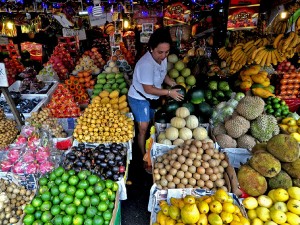
MANILA, Philippines–Concerned over surveys that showed Filipinos were eating more meat and chicken and less fruit and vegetables, lawmakers have suggested that part of the revenue raised from “sin taxes” be used to boost a healthy lifestyle campaign.
Sen. Gregorio Honasan said data compiled by the National Statistical Coordination Board (NSCB) from national nutrition surveys conducted from 1978 to 2008 merely confirmed fears of the poor food choices made by Filipinos in the face of urbanization and changing lifestyles.
“There are a lot of factors why Filipinos eat less fruits and vegetables and more meat and poultry and one of them is the mass migration to urban centers and the stress of a city lifestyle during the last three decades. Lifestyles have changed and sadly our nutrition has taken a big hit for it,” said Honasan.
Honasan, vice chair of the Senate committee on health and demography, said the government should take a more active role in reminding the public about the benefits of keeping a balanced diet and active lifestyle
Iloilo Rep. Janette Garin, vice chair of the House committee on health, shared Honasan’s concerns as she noted that chronic diseases had “alarmingly increased.” She blamed this on Filipino eating habits and a growing sedentary lifestyle “wherein people take a tricycle even for short distances.”
Garin said the government has to step up its awareness campaign on having a healthy lifestyle and eating habits.
She proposed that part of the revenue raised from the recently approved sin tax hike, or levies on cigarettes and alcohol products, be diverted to this information campaign.
“The impact of these diseases should not be underestimated. Exercise, healthy eating with the inclusion of fruits and vegetables, plus adequate sleep should be encouraged,” said Garin in a text message.
NSCB Secretary General Jose Ramon Albert said his agency’s report, released Dec. 30, showed that Filipinos ate an average of 58 grams of meat products a day in 2008, up 152 percent from 23 grams in 1978. Filipinos are also eating more chicken at an average of 25 grams per day in 2008, up from 7 grams in 1978.
“With these observed increases, it is not surprising that increases were likewise observed in fats and oil consumption, which increased by 15.4 percent (from 13 grams per day in 1978 to 15 grams in 2008,” said Albert.
In the same period, the eating of fish, which accounts for the bulk of the Filipinos’ diet, increased by 7.8 percent to 110 grams per day in 2008 from 102 grams in 1978.
The same report showed Filipinos eating fewer vegetables (down 24 percent to 110 grams in 2008 from 145 grams in 1978) and fruits (down 48 percent to 54 grams in 2008 from 104 grams in 1978).
Albert noted that these distinct changes in food consumption came in tandem with the rise of heart diseases as the primary cause of death in the country from 1990 to 2006.
Albert said that in the 1980s, heart disease was second to pneumonia as the main cause of mortality among Filipinos. “Is this the effect of our preference for high octane food over fruits and veggies?” he asked, noting an alarming increase in cancer among the top five leading causes of death in the country.
“While this may be partly an issue of better identification of cancer, it also may suggest something about our nutrition and lifestyle choices.”